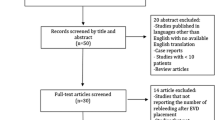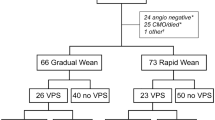Abstract
Acute hydrocephalus is a well-documented complication of subarachnoid hemorrhage. The insertion of external ventricular drainage (EVD) has been the standard of care in the management of this complication, aiming primarily at immediate improvement of the clinical condition of these patients, making them more suitable candidates for surgical or endovascular intervention. In our current communication, we review the pertinent literature regarding the relationship of rebleeding and EVD. Several studies have implicated a significantly increased risk of rebleeding in patients with EVD, compared with patients without it. Abrupt lowering of the intracranial pressure could lead to rebleeding due to decreased transmural pressure or removal of the clot sealing the previously ruptured aneurysm. However, a variety of parameters that could affect the rebleeding rate, such as the timing of surgery, the timing and duration of drainage, the size of the aneurysm, as well as the severity of the initial hemorrhage, do not seem to have been adequately explored in the majority of these studies. In addition, a number of clinical trials have failed to provide evidence for the negative role of EVD in the development of rebleeding. Conclusively, further long-term multi-center studies are required in order to establish the exact nature of the relationship between EVD and rebleeding after aneurysmal subarachnoid hemorrhage.
Similar content being viewed by others
References
Ambrose J (1964) Pulsed ultrasound. Illustrations of clinical applications. Br J Radiol 37:165–178
Bagley C Jr (1928) Blood in the cerebrospinal fluid. Resultant functional and organic alterations in the central nervous system. A. Experiment data. Arch Surg 17:18–38
Black PM (1986) Hydrocephalus and vasospasm after subarachnoid hemorrhage from ruptured intracranial aneurysms. Neurosurgery 18:12–16
Blaylock RL, Kempe LG (1978) Hydrocephalus associated with subarachnoid haemorrhage. Neurochirurgie 21:20–28
Bogdahn U, Lau W, Hassel W, et al (1992) Continuous-pressure controlled, external ventricular drainage for treatment of acute hydrocephalus-evaluation of risk factors. Neurosurgery 31:898–904
Connolly ES, Kader AA, Frazzini VI, et al (1997) The safety of intraoperative lumbar subarachnoid drainage for acutely ruptured intracranial aneurysm: technical note. Surg Neurol 48:338–344
Crompton MR (1966) Recurrent haemorrhage from cerebral aneurysms and its prevention by surgery. J Neurol Neurosurg Psychiatry 29:164–170
Editorial (1977) Communicating hydrocephalus. Lancet 2:1011–1012
Ferguson GG (1972) Physical factors in the initiation, growth, and rupture of human intracranial saccular aneurysms. J Neurosurg 37:666–677
Foltz EL, Ward AA Jr (1956) Communicating hydrocephalus from subarachnoid hemorrhage. J Neurosurg 30:651–657
Galera GR, Greitz T (1970) Hydrocephalus in the adult secondary to the rupture of intracranial arterial aneurysms. J Neurosurg 32:634–641
Hasan D, Lindsay KW, Vermeulen M (1991) Treatment of acute hydrocephalus after subarachnoid hemorrhage with serial lumbar puncture. Stroke 22:190–194
Hasan D, Vermeulen M, Wijdicks EFM et al (1989) Management problems in acute hydrocephalus after subarachnoid hemorrhage. Stroke 20:747–753
Inagawa T, Kamiya K, Ogasawara H et al (1987) Rebleeding of ruptured intracranial aneurysms in the acute stage. Surg Neurol 28:93–99
Juvela S (1989) Rebleeding from ruptured intracranial aneurysms. Surg Neurol 32:323–326
Kassell NF, Torner JC (1983) Aneurysmal rebleeding: a preliminary report from the cooperative aneurysm study. Neurosurgery 13:479–481
Kawai K, Nagashima H, Narita K, et al (1997) Efficacy and risk of ventricular drainage in cases of grade V subarachnoid hemorrhage. Neurol Res 19:649–653
Kibler RF, Couch RSC, Crompton MR (1961) Hydrocephalus in the adult following spontaneous subarachnoid haemorrhage. Brain 84:45–61
Klimo P, Kestle JR, MacDonald JD et al (2004) Marked reduction of cerebral vasospasm with lumbar drainage of cerebrospinal fluid after subarachnoid hemorrhage. J Neurosurg 100:215–224
Klopfenstein JD, Kim LJ, Feiz-Erfan I et al (2004) Comparison of rapid and gradual weaning from external ventricular drainage in patients with aneurysmal subarachnoid hemorrhage: a prospective randomized trial. J Neurosurg 100:225–229
Knibestol M, Karadayi A, Tovi D (1976) Echo-encephalographic study of ventricular dilatation after subarachnoid hemorrhage, with special reference to the effect of antifibrinolytic treatment. Acta Neurol Scand 54:57–70
Kusske JA, Turner PT, Ojemann GA et al (1973) Ventriculostomy for the treatment of acute hydrocephalus following subarachnoid hemorrhage. J Neurosurg 38:591–595
McIver JI, Friedman JA, Wijdicks EFM, et al (2002) Preoperative ventriculostomy and rebleeding after aneurysmal subarachnoid hemorrhage. J Neurosurg 97:1042–1044
Milhorat TH (1987) Acute hydrocephalus after aneurysmal subarachnoid hemorrhage. Neurosurgery 20:15–20
Mizukami M, Kin H, Araki G et al (1976) Communicating hydrocephalus following the rupture of intracranial aneurysms. Neurol Surg 4:33–41
Nornes H (1973) The role of intracranial pressure in the arrest of hemorrhage in patients with ruptured intracranial aneurysm. J Neurosurg 32:226–234
O’Neill P, West CR, Chadwick DW et al (1988) Recurrent aneurysmal subarachnoid hemorrhage: incidence, timing and effects. A re-appraisal in a surgical series. Br J Neurosurg 2:43–48
Pare L, Delfino R, Leblanc R (1992) The relationship of ventricular drainage to aneurysmal rebleeding. J Neurosurg 76:422–427
Pertuiset B, Heuttevile B, Margent P (1977) Dilatation ventriculaire, precoce et hydrocephalie consecutives a la rupture d’aneurysms arteriels sus-tentoriels. Neurochirurgica 15:113–126
Pickard JD (1984) Early posthemorrhagic hydrocephalus. Br Med J 289:569–570
Raimondi AJ, Torres H (1973) Acute hydrocephalus as a complication of subarachnoid hemorrhage. Surg Neurol 1:23–26
Rajshekhar V, Harbaugh RE (1992) Results of routine ventriculostomy with external ventricular drainage for acute hydrocephalus following subarachnoid hemorrhage. Acta Neurochir 115:8–14
Roitberg BZ, Khan N, Alp MS et al (2001) Bedside external ventricular drain placement for the treatment of acute hydrocephalus. Br J Neurosurg 15:324–327
Rosenorn J, Westergard L, Hansen PH (1983) Mannitol-induced rebleeding from intracranial aneurysm. J Neurosurg 59:529–530
Shulman K, Martin BF, Popoff N, et al (1963) Recognition and treatment of hydrocephalus following spontaneous subarachnoid hemorrhage. J Neurosurg 20:1040–1047
Spallone A, Gaglliardi FM (1983) Hydrocephalus following aneurysmal subarachnoid hemorrhage. Zentralbl Neurochir 44:141–150
Sundbarg G, Ponten U (1976) ICP and CSF absorption impairment after subarachnoid hemorrhage, in Becks JWF, Bosch DA, Brock M (eds) Intracranial pressure III. Springer, Berlin Heidelberg New York, pp 139–146
Troupp H (1975) Intracranial pressure in hydrocephalus after subarachnoid haemorrhage. Zbl Neurochir 36:11–17
van Gijn, Hijdra A, Widjicks EFM et al (1985) Acute hydrocephalus after aneurysmal subarachnoid hemorrhage. J Neurosurg 63:355–362
Vassilouthis J, Richardson AE (1979) Ventricular dilation and communicating hydrocephalus following spontaneous subarachnoid hemorrhage. J Neurosurg 51:341–351
Voldby B, Enevoldsen EM (1982) Intracranial pressure changes following aneurysm rupture. J Neurosurg 56:754–789
Wilkinson HA, Wilson RB, Patel PP et al (1974) Corticosteroid therapy of experimental hydrocephalus after intraventricular-subarachnoid haemorrhage. J Neurol Neurosurg Psychiatry 37:224–229
Yasargil MG, Yonekawa Y, Zumstein B et al (1973) Hydrocephalus following spontaneous subarachnoid hemorrhage. Clinical features and treatment. J Neurosurg 39:474–479
Author information
Authors and Affiliations
Corresponding author
Additional information
A commentary on this paper is available at http://dx.doi.org/10.1007/s10143-005-0424-3
Rights and permissions
About this article
Cite this article
Fountas, K.N., Kapsalaki, E.Z., Machinis, T. et al. Review of the literature regarding the relationship of rebleeding and external ventricular drainage in patients with subarachnoid hemorrhage of aneurysmal origin. Neurosurg Rev 29, 14–18 (2006). https://doi.org/10.1007/s10143-005-0423-4
Received:
Revised:
Accepted:
Published:
Issue Date:
DOI: https://doi.org/10.1007/s10143-005-0423-4




